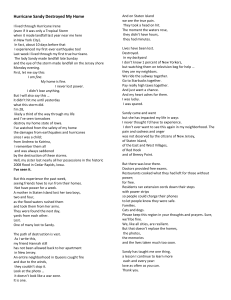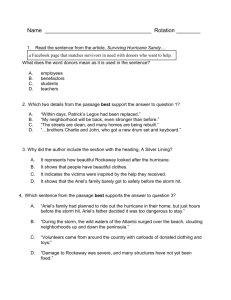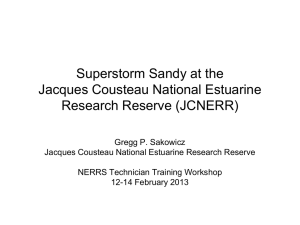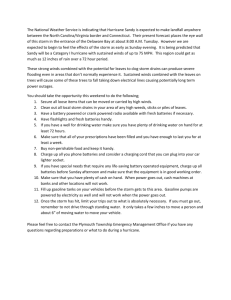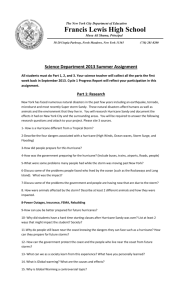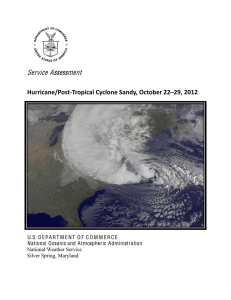Sandy — One Year Later By: Louis Uccellini, National Weather
advertisement
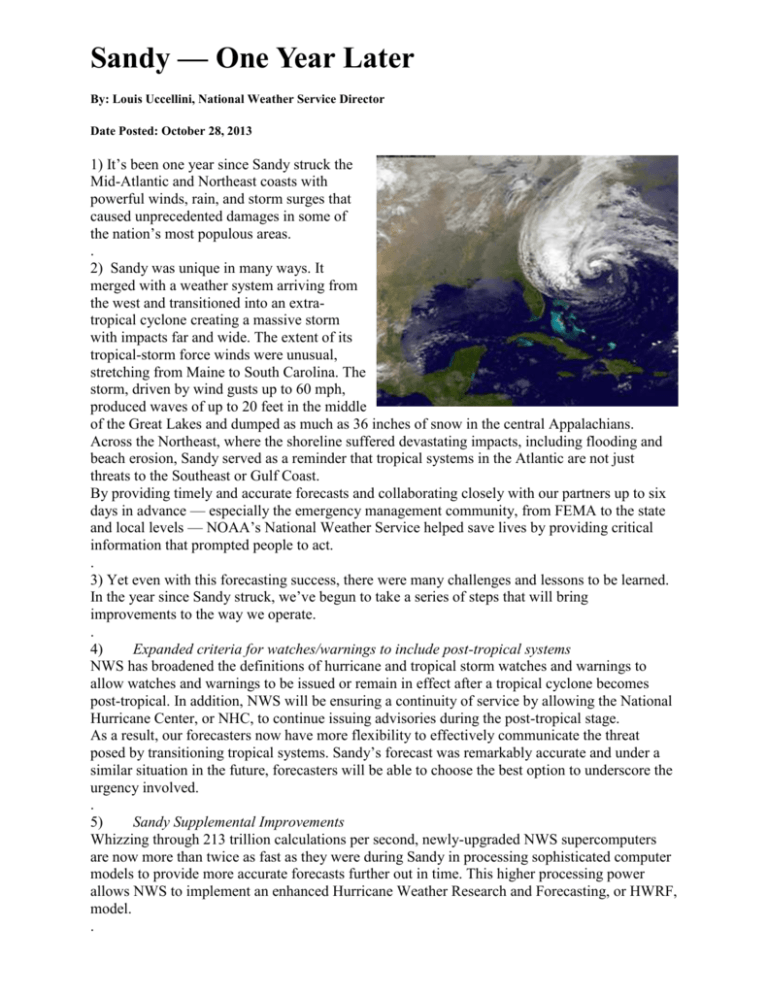
Sandy — One Year Later By: Louis Uccellini, National Weather Service Director Date Posted: October 28, 2013 1) It’s been one year since Sandy struck the Mid-Atlantic and Northeast coasts with powerful winds, rain, and storm surges that caused unprecedented damages in some of the nation’s most populous areas. . 2) Sandy was unique in many ways. It merged with a weather system arriving from the west and transitioned into an extratropical cyclone creating a massive storm with impacts far and wide. The extent of its tropical-storm force winds were unusual, stretching from Maine to South Carolina. The storm, driven by wind gusts up to 60 mph, produced waves of up to 20 feet in the middle of the Great Lakes and dumped as much as 36 inches of snow in the central Appalachians. Across the Northeast, where the shoreline suffered devastating impacts, including flooding and beach erosion, Sandy served as a reminder that tropical systems in the Atlantic are not just threats to the Southeast or Gulf Coast. By providing timely and accurate forecasts and collaborating closely with our partners up to six days in advance — especially the emergency management community, from FEMA to the state and local levels — NOAA’s National Weather Service helped save lives by providing critical information that prompted people to act. . 3) Yet even with this forecasting success, there were many challenges and lessons to be learned. In the year since Sandy struck, we’ve begun to take a series of steps that will bring improvements to the way we operate. . 4) Expanded criteria for watches/warnings to include post-tropical systems NWS has broadened the definitions of hurricane and tropical storm watches and warnings to allow watches and warnings to be issued or remain in effect after a tropical cyclone becomes post-tropical. In addition, NWS will be ensuring a continuity of service by allowing the National Hurricane Center, or NHC, to continue issuing advisories during the post-tropical stage. As a result, our forecasters now have more flexibility to effectively communicate the threat posed by transitioning tropical systems. Sandy’s forecast was remarkably accurate and under a similar situation in the future, forecasters will be able to choose the best option to underscore the urgency involved. . 5) Sandy Supplemental Improvements Whizzing through 213 trillion calculations per second, newly-upgraded NWS supercomputers are now more than twice as fast as they were during Sandy in processing sophisticated computer models to provide more accurate forecasts further out in time. This higher processing power allows NWS to implement an enhanced Hurricane Weather Research and Forecasting, or HWRF, model. . 6) With improved physics and a storm-tracking algorithm, the model has displayed up to a 15 percent improvement in both hurricane track and intensity forecasts, compared to last year’s version of the model. The upgraded HWRF is also capable of processing real-time data collected from the inner core of a tropical system by the tail Doppler radar attached to NOAA’s P3 hurricane hunter aircraft, data which are expected to produce even greater forecast improvements. 7) This lays the foundation for further computing enhancements and more accurate forecast models that are within reach over the next three years. Extending the central computing system to 1.5 petaflops represents a game-changer for the entire weather enterprise. In addition to the benefits to our own forecasters and products, these upgrades allow us to provide our private sector partners with better information to empower them to enhance their services. 8) These enhancements are a result of the Sandy Supplemental Appropriations Act which provide NOAA with unprecedented opportunities to strengthen NWS. The Act provides $48 million in supplemental funding for Sandy recovery efforts and to improve response and recovery capability for future weather events. The funding will allow the NWS to make critical improvements in several areas, including: High-speed computing Higher resolution weather prediction models Key observation systems 9) These upgrades will enable more accurate, consistent and longer lead time forecasts in advance of high-impact weather events. More accurate weather prediction models help our forecasters provide better information to decision makers who must make critical decisions, such as whether or not to evacuate an area due to storm surge from a hurricane, or order truckloads of bottled water and extra portable generators days prior to a crippling winter storm. 10) Storm Surge Modeling Storm surge created some of Sandy’s most devastating impacts. To forecast storm surge, the NHC uses the SLOSH (Sea, Lake and Overland Surges from Hurricanes) model. Thanks to increased computer speeds, NHC is able to run more model scenarios than in the past, providing a better picture of potential surges. 11) Beginning in 2014, NHC will introduce an experimental inundation graphic onto its website. This graphic will depict the height of water above ground from an approaching tropical or posttropical cyclone. 12) Beginning in 2015, NWS will implement watches and warnings explicitly for the storm surge hazard. It was the storm surge hazard that caused numerous fatalities and most of the damage with Sandy, as well as the extensive evacuations necessary to prevent an even larger loss of life. 13) Sandy was one of the most unusual and challenging storms in recent history and its impacts are still being felt by those who suffered the most from its devastation. By focusing on what we’ve learned from the impacts of Sandy, NOAA and NWS are working to build a WeatherReady Nation: a Nation in which people are prepared to deal with high-impact weather, water, and climate events, despite where they occur or what specific hazards they bring

